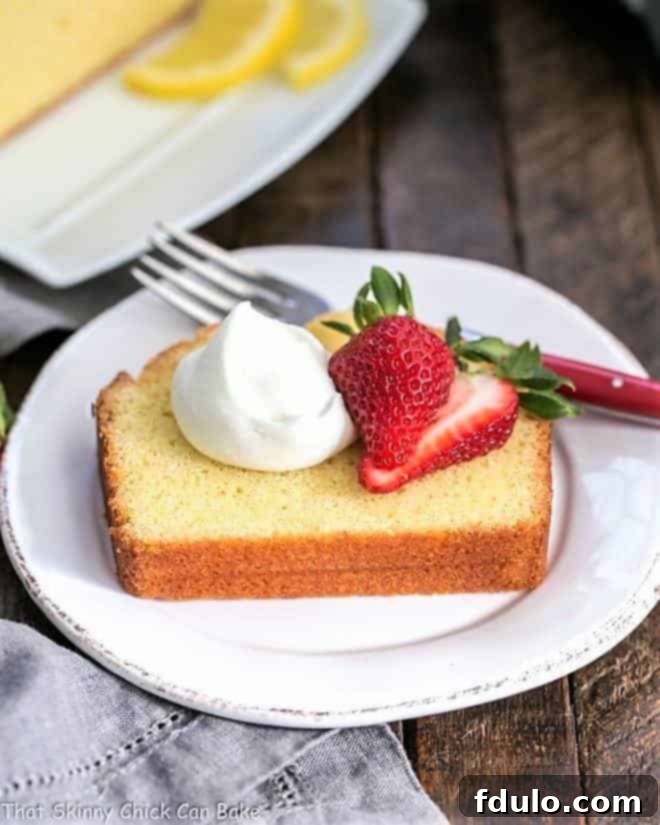There’s an undeniable charm to a perfectly baked Glazed Lemon Pound Cake. It’s more than just a dessert; it’s a slice of pure sunshine, a burst of bright, zesty flavor that effortlessly elevates any day. This particular recipe promises a supremely moist, tender, and dense crumb, crowned with a simple yet incredibly vibrant lemon glaze that truly makes it sing. Get ready to transform your kitchen into a fragrant citrus haven and delight your taste buds with this unforgettable lemon loaf.
Beyond the sheer deliciousness, lemon desserts hold a special place in our hearts. They offer a refreshing counterpoint to richer treats and bring a touch of brightness, no matter the season. Whether you’re a seasoned baker or just starting, this moist lemon cake recipe is designed to be straightforward and rewarding, ensuring a stunning result that tastes as good as it looks. In fact, many of my fellow food bloggers are also celebrating the versatility of citrus with their own amazing recipes. Scroll down to discover a collection of scrumptious lemon, orange, and lime-flavored dishes that you’ll definitely want to add to your culinary repertoire.

Why This Glazed Lemon Pound Cake Is A Must-Bake
If you’re looking for a dessert that combines classic comfort with bright, refreshing flavors, this Glazed Lemon Pound Cake is your answer. It’s not just a recipe; it’s an experience waiting to happen. Here’s why this particular lemon loaf deserves a prime spot in your baking rotation:
- A Ray of Sunshine Anytime: While we eagerly await the bounty of summer produce, vibrant citrus recipes like this one are the perfect way to bring fresh, bold flavors into your home. The intense lemon zest and juice in this pound cake provide that much-needed zesty kick, making it a delightful treat year-round. It’s a wonderful reminder of sunny days, even on the gloomiest of afternoons.
- Perfectly Portioned Pleasure: Unlike larger Bundt cakes that can feel daunting to tackle or consume, this Lemon Loaf Cake recipe is ideally sized. It strikes the perfect balance, satisfying those intense dessert cravings without leaving you with an overwhelming amount of cake. It’s just right for a family gathering, a small celebration, or simply enjoying slices throughout the week.
- Elegance in Simplicity or Grandeur: This pound cake is a star on its own, with its delicate crumb and gleaming lemon glaze for cake. But its versatility truly shines when you consider the endless ways to dress it up. Imagine a warm slice adorned with a dollop of freshly whipped cream, or a scoop of creamy vanilla bean ice cream. For an extra touch of fruitiness, add a medley of fresh, plump berries – macerated strawberries, juicy raspberries, or sweet blueberries – all complement the lemon beautifully.
- The Magic of a Warm Slice: Don’t underestimate the power of a gently warmed slice! A quick reheat in the microwave transforms this pound cake into an even more decadent experience. The butter seems to intensify, and the cake becomes wonderfully gooey and soft, making it an irresistible treat. Paired with its simple yet effective lemon glaze, which not only adds a beautiful sheen but also locks in moisture, every bite is a pure delight.
- Simple Ingredients, Incredible Flavor: This recipe relies on common pantry staples, yet the result is anything but ordinary. The combination of fresh lemon, butter, and sugar creates a depth of flavor that is both comforting and exhilarating.
- Impressive Yet Effortless: Despite its sophisticated appearance and incredible taste, this homemade lemon cake is surprisingly easy to make. The steps are straightforward, and the expert tips provided will guide you to baking success, even if you’re new to pound cakes.
Mastering the Art of Pound Cake: Expert Tips for Success
Pound cakes are renowned for their dense, rich texture and fine, velvety crumb. Achieving this perfect consistency requires attention to a few key details. Follow these expert tips to ensure your Glazed Lemon Pound Cake turns out beautifully every time:
- The Golden Rule: Room Temperature Ingredients: PRO-Tip: Always start with room-temperature eggs and butter. This is paramount for creating a smooth, emulsified batter. Cold ingredients won’t incorporate properly, leading to a lumpy batter and a less consistent cake texture. Room temperature butter creams beautifully with sugar, creating tiny air pockets essential for a tender crumb, and room temperature eggs integrate seamlessly without curdling the mixture.
- Quick Fix for Cold Eggs: PRO-Tip: Forgot to take your eggs out ahead of time? No problem! Place them in a bowl of very warm (not hot or boiling) tap water for 15-20 minutes. This will gently bring them to the ideal temperature without cooking them.
- Creaming Butter and Sugar to Perfection: Ensure the butter and sugar are creamed together thoroughly until light, fluffy, and pale yellow. This process incorporates air, which is vital for the cake’s structure and its signature velvety texture. Don’t rush this step; it’s fundamental to a truly great pound cake.
- Adding Eggs Smartly: PRO-Tip: Add eggs one at a time, beating well after each addition until just combined. This allows each egg to fully emulsify with the butter-sugar mixture before the next is added, preventing the batter from breaking. More importantly, avoid over-mixing once the eggs are in, as excessive mixing can develop the gluten in the flour too much, leading to a tough cake, and it can also incorporate too much air, which will alter the dense, fine-crumbed texture characteristic of a pound cake.
- Precise Pan Preparation: Properly preparing your baking pan is crucial to prevent sticking and ensure an easy release. If you’re using a non-stick pan, a baking spray with flour (like Baker’s Joy) works wonderfully. For regular pans, I highly recommend greasing it generously with shortening, then dusting it thoroughly with flour, tapping out any excess. This creates a reliable barrier.
- The Art of Cooling: PRO-Tip: Once out of the oven, allow your cake to cool in the pan for about 10-15 minutes. This crucial resting period allows the cake’s delicate structure to set and the crust to firm up, making it less prone to breaking when inverted. However, don’t leave it in the pan for too long, as it might start to stick as it cools completely. After this initial cooling, gently remove it from the pan and transfer it to a wire rack to cool completely to room temperature. This prevents the bottom from becoming soggy due to trapped steam.
- Measure Flour Correctly: For a consistently moist and tender cake, always measure your flour using the spoon-and-level method. Spoon flour into your measuring cup until it overflows, then level it off with a straight edge. Scooping directly can pack too much flour, resulting in a dry cake.
- Don’t Peek Too Early: Resist the urge to open the oven door during the first 3/4 of the baking time. Sudden temperature changes can cause the cake to collapse. Trust your oven and the timer.
- Test for Doneness Reliably: To check if your pound cake is done, insert a wooden skewer or toothpick into the center. It should come out clean or with a few moist crumbs attached, but no wet batter.

Frequently Asked Questions About Lemon Pound Cake
The name “pound cake” comes from a historical method of baking, specifically a recipe that used a pound each of four main ingredients: flour, sugar, butter, and eggs. This resulted in a very dense, rich, and often large cake. While modern recipes, like this easy lemon loaf cake, have evolved to include leavening agents like baking powder and adjusted ratios for optimal texture and flavor, the name remains a nod to this traditional origin. The emphasis is still on a rich, buttery, and substantial cake, distinct from lighter, airy sponges.
Achieving that irresistible, bright lemon flavor is all about maximizing the citrus oils. Here are the best techniques:
- Lemon Zest is Key: The zest contains all the aromatic oils. Always use fresh lemon zest. For an extra boost, use Dorie Greenspan’s brilliant method: rub the lemon zest together with the sugar using your fingertips. This action helps to release the lemon oil from the zest, allowing the sugar crystals to absorb it, creating a truly fragrant, lemon-infused sugar that will permeate your entire cake batter.
- Fresh Lemon Juice: Adding fresh lemon juice directly into the batter provides a tangy, bright counterpoint to the sweetness.
- Lemon Extract (Optional): For an even more intense lemon kick, a high-quality lemon extract can be added, though it’s often not strictly necessary when using ample fresh zest and juice.
- Lemon Glaze: A simple lemon glaze for cake made with fresh lemon juice and powdered sugar is a fantastic way to add another layer of intense lemon flavor and moisture after baking. The glaze soaks into the warm cake, ensuring every bite is bursting with citrus.
Absolutely! Pound cakes are incredibly versatile when it comes to citrus. You can easily swap out the lemon zest and juice for orange, lime, or even grapefruit. Adjust the sugar in the glaze if using a particularly tart citrus. The principles of the recipe will remain the same, delivering a delicious citrus-flavored loaf cake.
To keep your Glazed Lemon Pound Cake fresh and moist, wrap any leftovers tightly in plastic wrap or aluminum foil. Store it at room temperature for up to 3-4 days. For longer storage, you can freeze individual slices or the whole loaf (unglazed or lightly glazed) for up to 2-3 months. Thaw at room temperature before serving.
The incredible moistness of this Best Lemon Pound Cake comes from several factors. Firstly, the generous amount of butter and eggs in the recipe provides rich fat and moisture. Secondly, the careful creaming of butter and sugar, along with the precise addition of eggs, creates a stable emulsion. Finally, the lemon glaze for cake plays a crucial role; when brushed onto the still-warm cake, it soaks in, adding an extra layer of moisture and a tangy sweetness that keeps the crumb wonderfully tender for days.
More Citrus Delights You May Also Like:
If you’ve fallen in love with the bright flavors of this lemon pound cake, you’re in for a treat! Explore these other fantastic citrus-inspired recipes from my kitchen and those of my talented blogging friends:
- Orange Frosty from Creative Culinary – A refreshing, creamy orange drink.
- Best Lemon Bars – Tangy, sweet, and perfectly tart.
- Glazed Lemon Tea Scones – A delightful treat for afternoon tea.
- Strawberry Lemon Tart – A beautiful combination of sweet strawberries and zesty lemon.
- Lemon Bar Cheesecake – Two favorite desserts in one irresistible creation.
- Check out all my Best Cake Recipes for more baking inspiration.
Stay in touch and share your baking creations with me! Follow on Instagram, Facebook, and Pinterest. Don’t forget to tag me when you try one of my recipes! If you love the results, please consider giving it a 5-star rating in the recipe card below – it truly helps!


Glazed Lemon Pound Cake Recipe
20 minutes
1 hour 15 minutes
1 hour 35 minutes
10 servings
A classic, dense, and supremely moist lemon loaf cake elevated with a simple, tangy lemon glaze. This Best Lemon Pound Cake recipe is perfect for brightening any day!
Ingredients
For the Cake:
- 1 cup (2 sticks) unsalted butter, at room temperature
- 1 ¼ cups granulated sugar
- 2 tablespoons fresh lemon zest (from 2-3 lemons)
- 4 large eggs, at room temperature
- 2 teaspoons fresh lemon juice
- 1 ½ teaspoons pure vanilla extract
- 1 ½ cups all-purpose flour, spooned and leveled
- 1 teaspoon baking powder
- ½ teaspoon fine sea salt
For the Glaze:
- ½ cup granulated sugar
- ¼ cup fresh lemon juice
Instructions for the Perfect Lemon Pound Cake
- Prepare Your Pan: Preheat your oven to 350°F (175°C). Line the bottom of a large loaf pan (approximately 9x5x2.5 inches, or a 1-pound loaf pan) with parchment paper, allowing some overhang on the sides for easy removal. Grease the sides of the pan well or use a baking spray with flour. Set aside.
- Infuse the Sugar with Lemon: In a large mixing bowl, combine the granulated sugar and fresh lemon zest. Using your fingertips, rub the zest into the sugar for a minute or two until the sugar becomes fragrant and takes on a pale yellow hue. This technique, inspired by Dorie Greenspan, effectively releases the lemon oils for maximum flavor.
- Cream Butter and Sugar: Add the softened room-temperature butter to the lemon-infused sugar. Beat with an electric mixer on medium speed until the mixture is light, fluffy, and significantly paler in color (about 3-5 minutes). This step is crucial for incorporating air and creating a tender crumb.
- Add Eggs and Liquids: Add the eggs one at a time, beating well after each addition until just combined. The mixture may look slightly curdled at this stage, which is normal. Stir in the fresh lemon juice and vanilla extract until fully incorporated. Remember not to overmix here.
- Combine Dry Ingredients: In a separate medium bowl, whisk together the all-purpose flour, baking powder, and salt.
- Gently Fold in Dry Ingredients: Gradually add the sifted dry ingredients to the wet mixture, folding gently with a spatula until just combined and a smooth batter forms. Be very careful not to overmix, as this can lead to a tough, dry cake.
- Bake the Loaf: Spread the cake batter evenly into your prepared loaf pan. Bake for 15 minutes at 350°F (175°C). Then, reduce the oven temperature to 325°F (160°C) and continue baking for another 35-60 minutes, or until a wooden skewer inserted into the center comes out clean or with a few moist crumbs attached. (Baking times can vary, so keep an eye on it – mine often takes closer to an hour at the reduced temperature!).
- Initial Cooling: Remove the baked cake from the oven and place it on a wire cooling rack. Allow it to cool in the pan for 10-15 minutes. This resting period allows the cake to firm up before handling.
- Release from Pan: After the initial cooling, use the parchment paper overhang to gently lift the cake out of the pan. Place it upright directly on the wire rack to cool completely to room temperature.
- Prepare the Glaze: While the cake cools, make the lemon glaze. In a small saucepan, combine the ½ cup sugar and ¼ cup fresh lemon juice. Bring the mixture to a boil over medium heat, then reduce the heat to low and simmer for 2-3 minutes, stirring occasionally, until the glaze thickens slightly and becomes syrupy.
- Glaze the Cake: Once the cake is completely cool, use a toothpick or skewer to poke holes all over the top and sides of the loaf. This allows the glaze to penetrate deep into the cake. Generously brush the warm, syrupy lemon glaze over the entire cake, ensuring it seeps into the holes.
- Serve and Store: Allow the glaze to set for a few minutes before slicing and serving your magnificent Glazed Lemon Pound Cake. Wrap any leftovers well in plastic wrap and store at room temperature for maximum freshness.
Notes
This recipe for moist lemon cake has been adapted and perfected from classic techniques, including insights from Cook’s Illustrated, ensuring a consistently delicious result. For best flavor, always use freshly squeezed lemon juice and fresh zest.
Recommended Baking Tools
As an Amazon Associate and member of other affiliate programs, I earn from qualifying purchases. These are tools I personally recommend for baking success.
- Reynolds Kitchens Non-Stick Baking Parchment Paper Sheets – 12×16 Inch, 22 Count
- Microplane Zester for Citrus and Cheese
- Stainless Steel Loaf Pan
Nutrition Information:
Yield:
10
Serving Size:
1 slice
Amount Per Serving:
Calories: 399
Total Fat: 20g
Saturated Fat: 12g
Trans Fat: 1g
Unsaturated Fat: 7g
Cholesterol: 123mg
Sodium: 331mg
Carbohydrates: 50g
Fiber: 1g
Sugar: 35g
Protein: 5g
